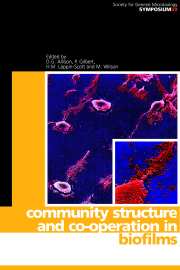Book contents
- Frontmatter
- Contents
- Contributors
- Editors' Preface
- An overview of biofilms as functional communities
- Initial microbial adhesion events: mechanisms and implications
- Physiological events in biofilm formation
- Environmental and genetic factors influencing biofilm structure
- Coaggregation and coadhesion in oral biofilms
- Cohesiveness in biofilm matrix polymers
- Microbial detachment from biofilms
- Modelling and predicting biofilm structure
- Microbial community interactions in biofilms
- Microbial communities: aggregates of individuals or co-ordinated systems
- Gene transfer in biofilms
- Population dynamics in microbial biofilms
- Biodegradation by biofilm communities
- Biofilms and prosthetic devices
- Biofilms: problems of control
- Biofilms in the New Millennium: musings from a peak in Xanadu
- Index
Editors' Preface
Published online by Cambridge University Press: 03 June 2010
- Frontmatter
- Contents
- Contributors
- Editors' Preface
- An overview of biofilms as functional communities
- Initial microbial adhesion events: mechanisms and implications
- Physiological events in biofilm formation
- Environmental and genetic factors influencing biofilm structure
- Coaggregation and coadhesion in oral biofilms
- Cohesiveness in biofilm matrix polymers
- Microbial detachment from biofilms
- Modelling and predicting biofilm structure
- Microbial community interactions in biofilms
- Microbial communities: aggregates of individuals or co-ordinated systems
- Gene transfer in biofilms
- Population dynamics in microbial biofilms
- Biodegradation by biofilm communities
- Biofilms and prosthetic devices
- Biofilms: problems of control
- Biofilms in the New Millennium: musings from a peak in Xanadu
- Index
Summary
The study of biofilm has been embraced by the microbiological community as it recognizes the profound effect that attachment of cells and cell populations to surfaces has upon their physiology and combined metabolic potential. Particularly, growth of microbial cells as communities, associated with interfaces, has been found to more directly address the many problems and opportunities associated with micro-organisms than do planktonic mono-culture studies. Fifteen years ago, the term ‘biofilm’ was mentioned in the abstracts and titles of approximately one scientific publication per week. Today, such citations occur every few hours and the wealth of literature captured by this umbrella term has burgeoned. The term biofilm is no longer definitive; rather it is an epithet indicative of an organism's or community's relationship to its natural habitat. Biofilm research, particularly at the community level, does not lend itself to reductionist experiments. Rather, the more one approaches the perfect experiment then the less flexible and informative it sometimes becomes! Inevitably, as the complexity of the system is increased then the range of outcomes and their interpretation broaden. In selecting the contributions to this symposium volume, we have tried not only to reflect the dynamic nature of microbial communities but also to represent the wide range of diverse disciplines that have been brought to bear on this topic. We particularly hope that the book and symposium will kindle the ‘biofilm’ spirit in the young researcher.
We would like to thank all of the contributors for their input to both the meeting and to the book, and express our sincere gratitude to Melanie Scourfield of the Society for her efficient and gentle handling of the Editors in the production of this volume.
- Type
- Chapter
- Information
- Community Structure and Co-operation in Biofilms , pp. xi - xiiPublisher: Cambridge University PressPrint publication year: 2000

